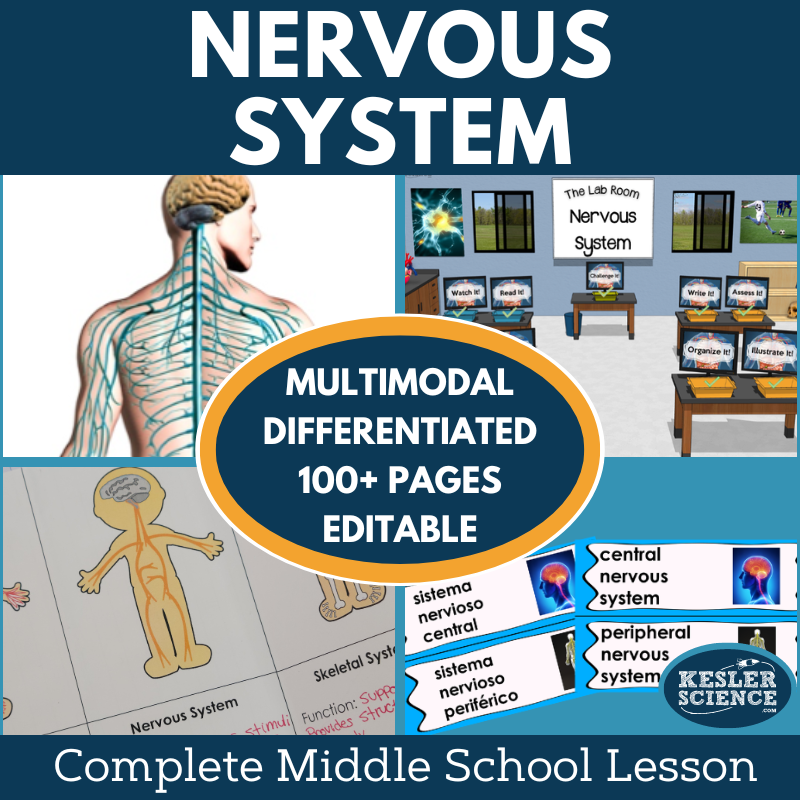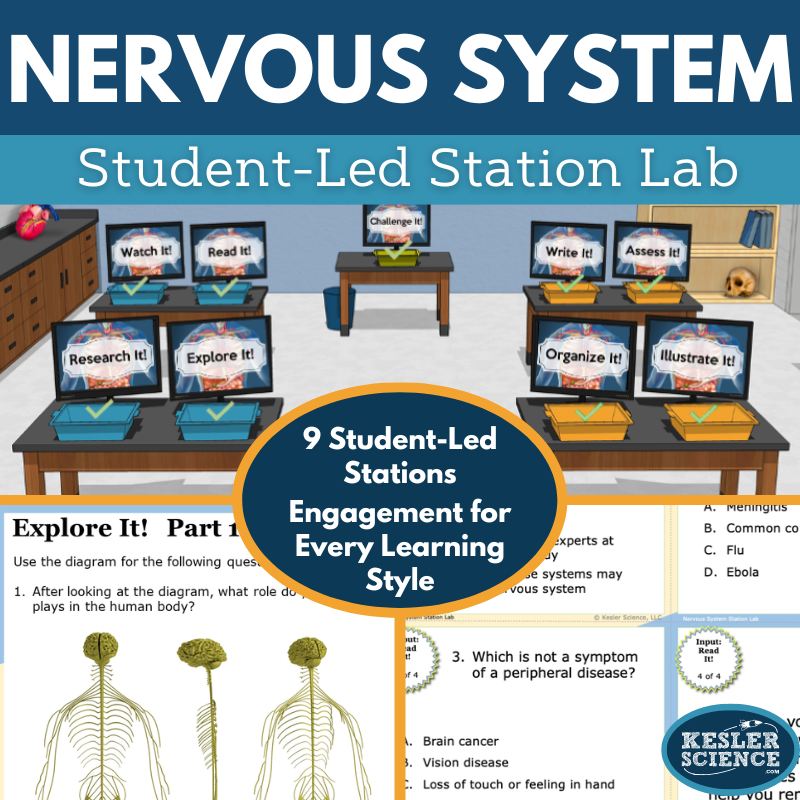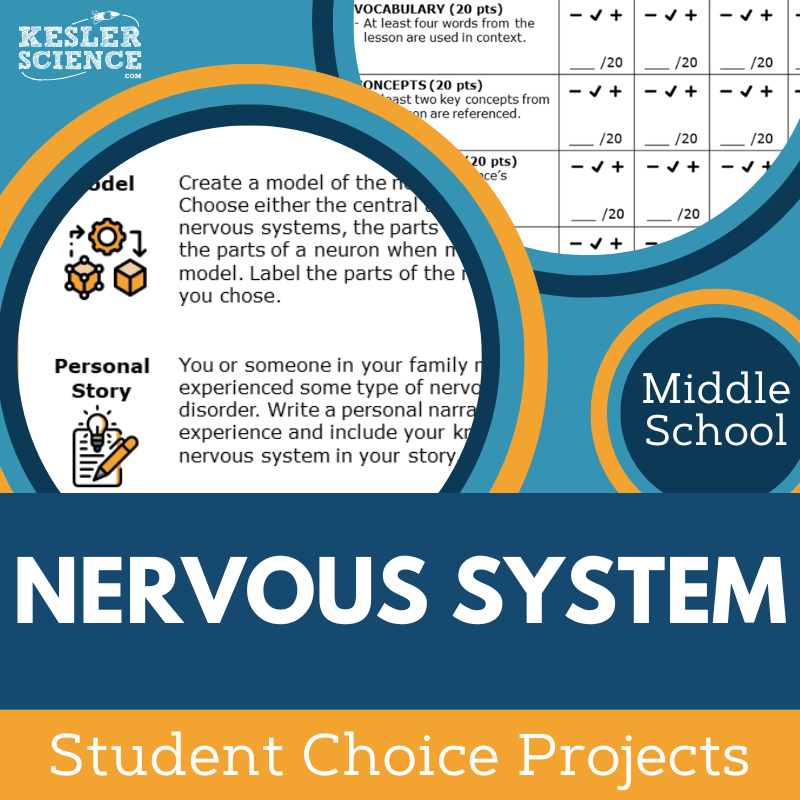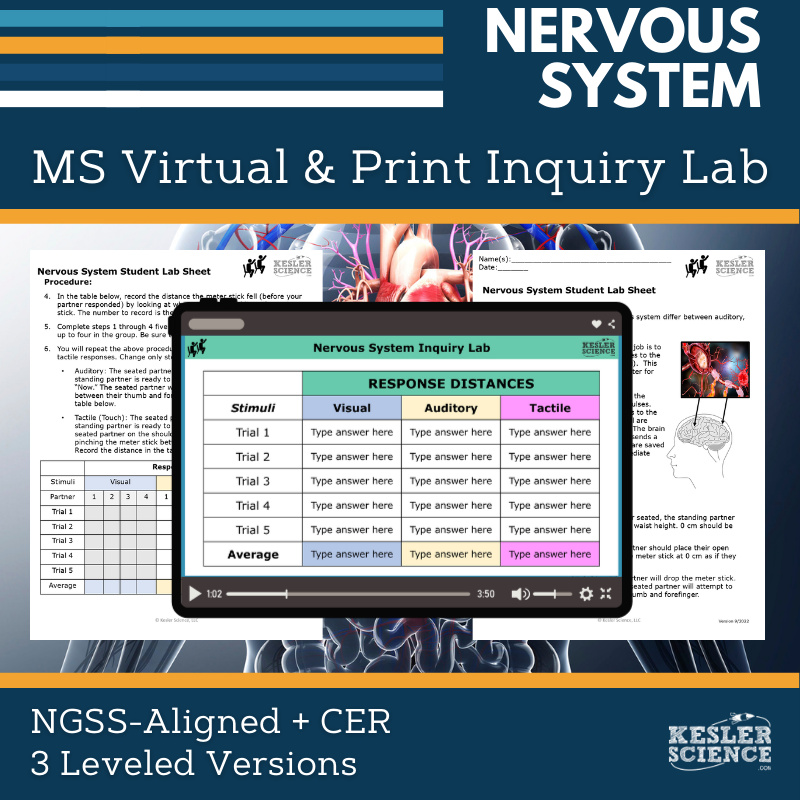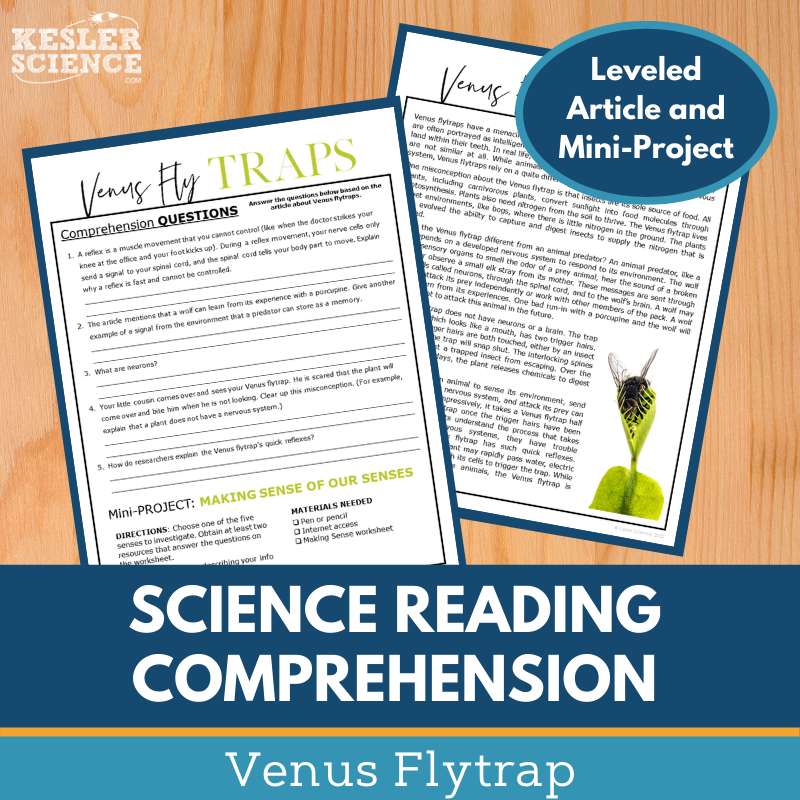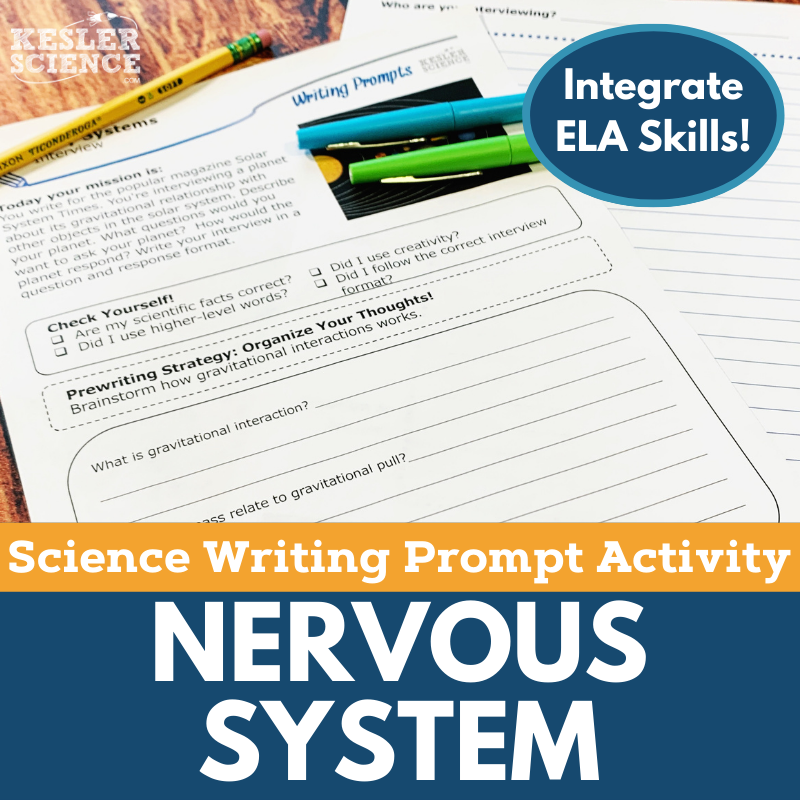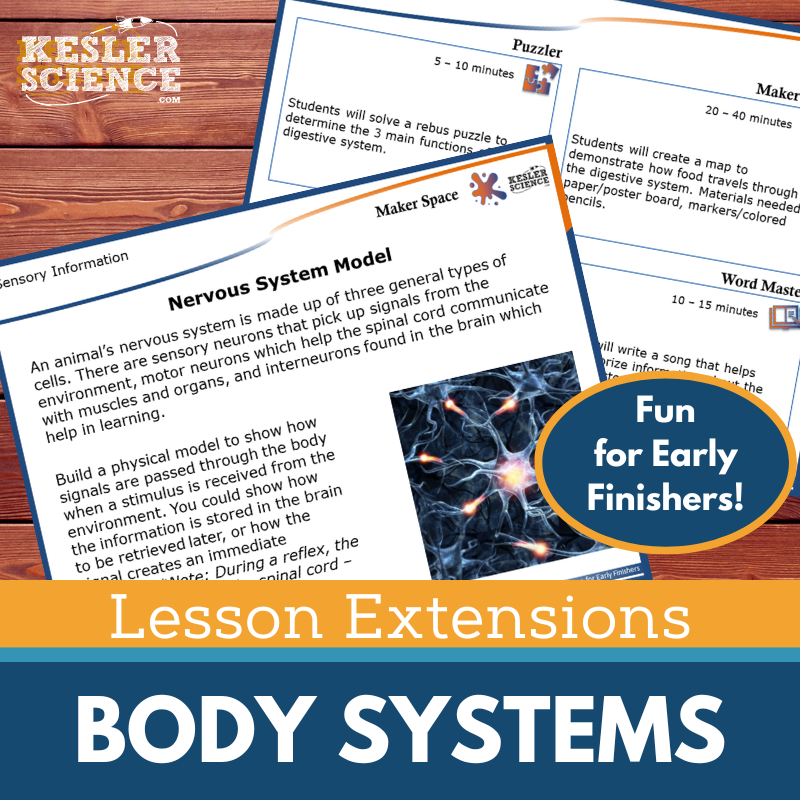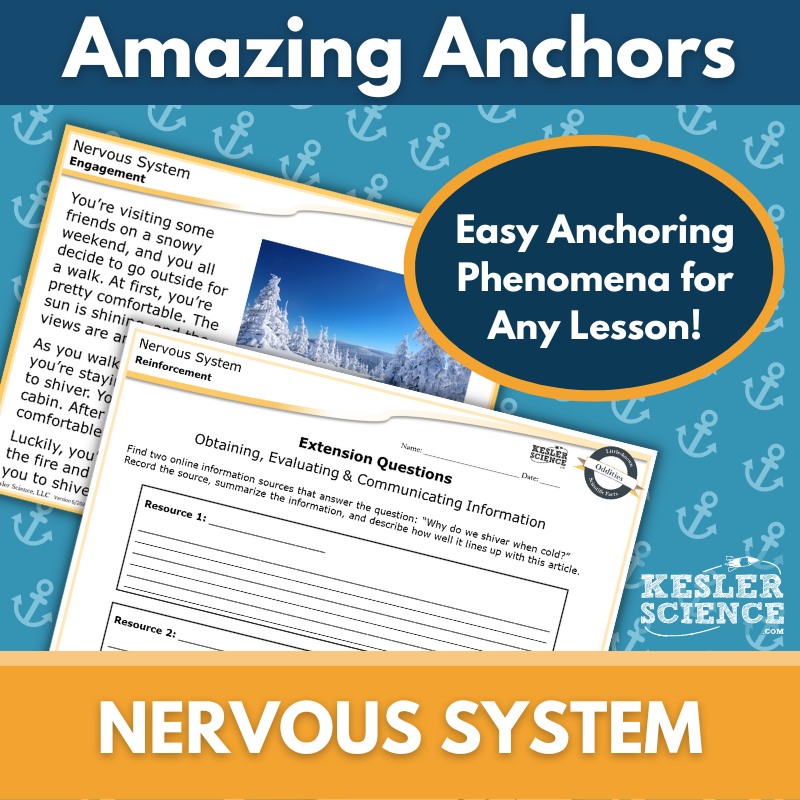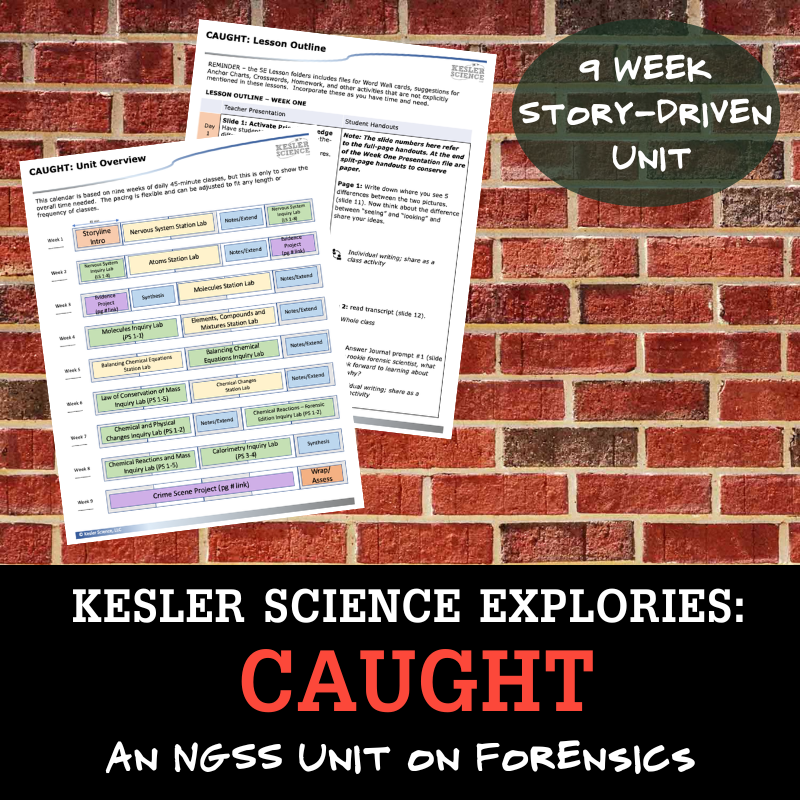Stimuli & Sensory Receptors Activities for Middle School Science
This middle school nervous system unit includes a range of resources such as presentations, worksheets, choice projects, and assessments, designed for student-led, differentiated learning with minimal prep. The resources below will give students a comprehensive understanding of the nervous system. All of the following materials are also included in the Kesler Science Membership.
This middle school nervous system unit includes presentations, worksheets, choice projects, and assessments, all designed for student-led, differentiated learning with minimal prep required. The lesson is aligned with the TEKS and NGSS standards and features editable PowerPoints, Spanish translations, and a multimodal approach to engage students.
Students explore essential questions about the structure and function of the nervous system and its main organs. The lesson is built around the 5E Model: Engagement, Exploration, Explanation, Elaboration, and Evaluation. In the Exploration phase, students engage in differentiated, hands-on stations such as reading, watching videos, conducting experiments, and completing activities like card sorts, drawing, and open-ended writing.
The Explanation phase includes editable PowerPoints, interactive notebooks, and note-taking templates. In Elaboration, students complete choice projects to extend learning. Evaluation consists of assessment questions aligned with STAAR 2.0 and review materials for class discussions, homework, or test practice. The lesson can be adapted for virtual learning, making it versatile for different learning environments.
This middle school nervous system unit includes presentations, worksheets, choice projects, and assessments, all designed for student-led, differentiated learning with minimal prep required. The lesson is aligned with the TEKS and NGSS standards and features editable PowerPoints, Spanish translations, and a multimodal approach to engage students.
Students explore essential questions about the structure and function of the nervous system and its main organs. The lesson is built around the 5E Model: Engagement, Exploration, Explanation, Elaboration, and Evaluation. In the Exploration phase, students engage in differentiated, hands-on stations such as reading, watching videos, conducting experiments, and completing activities like card sorts, drawing, and open-ended writing.
The Explanation phase includes editable PowerPoints, interactive notebooks, and note-taking templates. In Elaboration, students complete choice projects to extend learning. Evaluation consists of assessment questions aligned with STAAR 2.0 and review materials for class discussions, homework, or test practice. The lesson can be adapted for virtual learning, making it versatile for different learning environments.
This student-led activity on the nervous system engages middle school students while providing a comprehensive, low-prep way for them to direct their learning. Students will explore key concepts like the structures of the nervous system, the differences between the cerebellum and cerebrum, and how information flows in the body.
The station lab includes eight differentiated activities, plus a ninth challenge station for early finishers. Students work independently or in small groups, completing hands-on tasks, reading passages, watching videos, and using digital resources. The stations include "Explore It!" for hands-on demonstrations, "Research It!" with website-based tasks, "Read It!" with differentiated reading passages, and "Watch It!" for video analysis.
Output stations provide opportunities for students to organize information, illustrate models, write responses, and assess their understanding. The bonus challenge station offers extension activities for advanced learners. This resource is adaptable for both in-person and virtual learning environments.
This student-led activity on the nervous system engages middle school students while providing a comprehensive, low-prep way for them to direct their learning. Students will explore key concepts like the structures of the nervous system, the differences between the cerebellum and cerebrum, and how information flows in the body.
The station lab includes eight differentiated activities, plus a ninth challenge station for early finishers. Students work independently or in small groups, completing hands-on tasks, reading passages, watching videos, and using digital resources. The stations include "Explore It!" for hands-on demonstrations, "Research It!" with website-based tasks, "Read It!" with differentiated reading passages, and "Watch It!" for video analysis.
Output stations provide opportunities for students to organize information, illustrate models, write responses, and assess their understanding. The bonus challenge station offers extension activities for advanced learners. This resource is adaptable for both in-person and virtual learning environments.
The Nervous System Student Choice Projects lesson allows middle school students to select a project that suits their preferred output style. The project page outlines six student-led options along with a “design your own” project. A grading rubric is provided for assessments by teachers, peers, or students themselves.
These flexible projects cater to diverse learning needs, offering creative, multimodal ways for students to demonstrate their understanding. Teachers can adjust the rubric to align with grading requirements.
The lesson is differentiated to support students at various levels. The modified version includes three project options designed for remediation, while advanced learners can be challenged with a combination of projects.
Standard classroom supplies, such as paper, markers, and scissors, are sufficient for most projects, and digital options are available. Some projects may require crafting supplies for building models.
The Nervous System Student Choice Projects lesson allows middle school students to select a project that suits their preferred output style. The project page outlines six student-led options along with a “design your own” project. A grading rubric is provided for assessments by teachers, peers, or students themselves.
These flexible projects cater to diverse learning needs, offering creative, multimodal ways for students to demonstrate their understanding. Teachers can adjust the rubric to align with grading requirements.
The lesson is differentiated to support students at various levels. The modified version includes three project options designed for remediation, while advanced learners can be challenged with a combination of projects.
Standard classroom supplies, such as paper, markers, and scissors, are sufficient for most projects, and digital options are available. Some projects may require crafting supplies for building models.
This lab allows students to explore how the nervous system processes auditory, visual, and tactile stimuli at different rates. Students can engage with a virtual demonstration and pre-recorded video, or perform a hands-on printed experiment, both of which include comprehension questions, Claim-Evidence-Reasoning (C.E.R.) prompts, and a reflection section.
Differentiation is built in with three versions: Dependent (for on-level learners), Modified (for learners needing more support), and Independent (for advanced learners).
The lab addresses the NGSS standard MS LS1-8, focusing on how sensory receptors respond to stimuli and send messages to the brain. It can be used in print format, requiring a meter stick, or digitally, using a PowerPoint or Google Slides file that includes a video recording of the lab procedure. The digital format requires no materials and can be accessed virtually, perfect for students who are absent or without materials.
Teacher resources include editable PowerPoints, teacher keys, and support materials. Answer keys, C.E.R. statements, and additional resources are provided for planning and grading.
This lab allows students to explore how the nervous system processes auditory, visual, and tactile stimuli at different rates. Students can engage with a virtual demonstration and pre-recorded video, or perform a hands-on printed experiment, both of which include comprehension questions, Claim-Evidence-Reasoning (C.E.R.) prompts, and a reflection section.
Differentiation is built in with three versions: Dependent (for on-level learners), Modified (for learners needing more support), and Independent (for advanced learners).
The lab addresses the NGSS standard MS LS1-8, focusing on how sensory receptors respond to stimuli and send messages to the brain. It can be used in print format, requiring a meter stick, or digitally, using a PowerPoint or Google Slides file that includes a video recording of the lab procedure. The digital format requires no materials and can be accessed virtually, perfect for students who are absent or without materials.
Teacher resources include editable PowerPoints, teacher keys, and support materials. Answer keys, C.E.R. statements, and additional resources are provided for planning and grading.
In this lesson, students learn how sensory receptors respond to stimuli by reading a nonfiction article about Venus flytraps. They complete comprehension questions and research one of the five senses while engaging in a mini-project.
The resource, designed for middle school students, enhances both science literacy and reading comprehension. It includes leveled passages, 5-7 questions per reading, and a hands-on mini-project. Additionally, a Cornell notes template is provided. The passage can be used for in-person or virtual learning, with options for Google Classroom, MS Teams, Schoology, and Canvas.
This resource is ideal for absentee students, extra credit, sub plans, or whole-class activities. It encourages classroom discussions and helps build textual analysis and comprehension skills.
In this lesson, students learn how sensory receptors respond to stimuli by reading a nonfiction article about Venus flytraps. They complete comprehension questions and research one of the five senses while engaging in a mini-project.
The resource, designed for middle school students, enhances both science literacy and reading comprehension. It includes leveled passages, 5-7 questions per reading, and a hands-on mini-project. Additionally, a Cornell notes template is provided. The passage can be used for in-person or virtual learning, with options for Google Classroom, MS Teams, Schoology, and Canvas.
This resource is ideal for absentee students, extra credit, sub plans, or whole-class activities. It encourages classroom discussions and helps build textual analysis and comprehension skills.
The Nervous System Stimuli Science Writing Prompt Activity helps middle school students test their knowledge of life science by engaging them in a vocabulary story that strengthens their understanding of the nervous system. Aligned with MS LS1-8, this activity allows students to explore sensory receptors and their response to stimuli through writing. It supports both in-person and virtual learning environments.
The resource includes teacher directions with an answer guide and rubrics, projection and print versions of the prompt, full-sized and half-sheet handouts for student use, and a digital interactive version that can be saved as Google Slides. This activity is perfect for cross-curricular use, formative assessment, student projects, early finishers, and differentiation. It can also serve as extra credit, make-up work, or a TELPAS sample. The writing prompt works well in interactive notebooks or journals and can be displayed in a bulletin board or student anthology.
The Nervous System Stimuli Science Writing Prompt Activity helps middle school students test their knowledge of life science by engaging them in a vocabulary story that strengthens their understanding of the nervous system. Aligned with MS LS1-8, this activity allows students to explore sensory receptors and their response to stimuli through writing. It supports both in-person and virtual learning environments.
The resource includes teacher directions with an answer guide and rubrics, projection and print versions of the prompt, full-sized and half-sheet handouts for student use, and a digital interactive version that can be saved as Google Slides. This activity is perfect for cross-curricular use, formative assessment, student projects, early finishers, and differentiation. It can also serve as extra credit, make-up work, or a TELPAS sample. The writing prompt works well in interactive notebooks or journals and can be displayed in a bulletin board or student anthology.
The Body Systems Set includes 9 WIKI Tickets© formative assessments for 6th-8th grade science, offering flexible ways to check student understanding. Each topic has five formats: a full-screen projection version, three print handouts in full, split, and quarter-page sizes, and an interactive digital version for use with PowerPoint or Google Slides.
Aligned with NGSS and TEKS standards, the set covers topics such as the circulatory, digestive, endocrine, excretory, muscular, nervous, respiratory, and skeletal systems. Some topics have multiple tickets, with a bonus table of contents file included to show the alignment.
These assessments are suitable for both in-person and virtual learning environments. They can be used as exit tickets, bellringers, or other quick checks to gauge student progress. You can project them for classroom use, print handouts, or have students complete them digitally in a 1:1 or remote setting.
The Body Systems Set includes 9 WIKI Tickets© formative assessments for 6th-8th grade science, offering flexible ways to check student understanding. Each topic has five formats: a full-screen projection version, three print handouts in full, split, and quarter-page sizes, and an interactive digital version for use with PowerPoint or Google Slides.
Aligned with NGSS and TEKS standards, the set covers topics such as the circulatory, digestive, endocrine, excretory, muscular, nervous, respiratory, and skeletal systems. Some topics have multiple tickets, with a bonus table of contents file included to show the alignment.
These assessments are suitable for both in-person and virtual learning environments. They can be used as exit tickets, bellringers, or other quick checks to gauge student progress. You can project them for classroom use, print handouts, or have students complete them digitally in a 1:1 or remote setting.
Lesson Extensions are designed to engage fast finishers with student-choice activities that promote critical thinking and creativity. These activities are perfect for wrapping up lessons, filling time during testing, and keeping students focused with rigorous yet enjoyable learning opportunities. They align with NGSS and TEKS standards and help deepen students' understanding of body systems.
Each extension includes four activities: a Puzzler for problem-solving, Maker Space for hands-on STEAM projects, Tech Connection for digital demonstrations, and Word Master to encourage creative writing in science. The materials come with teacher directions, answer keys, and both digital and print versions for flexibility in the classroom.
The topics covered in the extensions include various body systems, such as the circulatory, digestive, endocrine, excretory, integumentary, muscular, nervous, respiratory, and skeletal systems, as well as sensory information. These activities provide a high-level challenge for independent learners while reinforcing core science concepts.
Lesson Extensions are designed to engage fast finishers with student-choice activities that promote critical thinking and creativity. These activities are perfect for wrapping up lessons, filling time during testing, and keeping students focused with rigorous yet enjoyable learning opportunities. They align with NGSS and TEKS standards and help deepen students' understanding of body systems.
Each extension includes four activities: a Puzzler for problem-solving, Maker Space for hands-on STEAM projects, Tech Connection for digital demonstrations, and Word Master to encourage creative writing in science. The materials come with teacher directions, answer keys, and both digital and print versions for flexibility in the classroom.
The topics covered in the extensions include various body systems, such as the circulatory, digestive, endocrine, excretory, integumentary, muscular, nervous, respiratory, and skeletal systems, as well as sensory information. These activities provide a high-level challenge for independent learners while reinforcing core science concepts.
This Amazing Anchors activity helps incorporate a real-world phenomenon into your middle school science lesson, aligned with NGSS and TEKS standards. It includes two readings: an introductory one about getting the shivers with comprehension and extension questions to prepare students for further learning, and an explanatory reading that breaks down the science behind the nervous system, also with comprehension and reinforcement questions.
Included in the resource are teacher directions, answer keys, projection slides for displaying content, a digital version for sharing via LMS, a paper version for handouts, and editable materials aligned with NGSS and TEKS standards. This lesson is designed to introduce and reinforce the nervous system through a real-world lens, fitting well into the Engagement and Elaborate segments of 5E lessons.
The resource is differentiated, offering a modified version to support students with sentence starters and easier language. It’s available in both print and digital formats, compatible with platforms like Google Classroom.
This Amazing Anchors activity helps incorporate a real-world phenomenon into your middle school science lesson, aligned with NGSS and TEKS standards. It includes two readings: an introductory one about getting the shivers with comprehension and extension questions to prepare students for further learning, and an explanatory reading that breaks down the science behind the nervous system, also with comprehension and reinforcement questions.
Included in the resource are teacher directions, answer keys, projection slides for displaying content, a digital version for sharing via LMS, a paper version for handouts, and editable materials aligned with NGSS and TEKS standards. This lesson is designed to introduce and reinforce the nervous system through a real-world lens, fitting well into the Engagement and Elaborate segments of 5E lessons.
The resource is differentiated, offering a modified version to support students with sentence starters and easier language. It’s available in both print and digital formats, compatible with platforms like Google Classroom.
"Explories: CAUGHT” is an NGSS unit where students join a fictitious Forensics Academy to learn chemistry and evidence-gathering skills needed to solve a non-violent crime. Throughout the unit, students will progress through levels of training, earning badges as they go. They begin by studying the nervous system and sensory processes, then apply these concepts to analyze crime scene evidence. As they progress, they will learn chemistry principles to analyze substances like lipstick and blood. By the end of the unit, students will have a complete Rookie Handbook to help them solve their first case.
This resource includes day-by-day teacher instructions, two unit projects, six station labs, eight inquiry labs, six 5E lessons, student activity pages, project-based and traditional assessments, rubrics for feedback and standards-based grading, journaling/synthesis activities, and two training videos.
Aligned with NGSS standards, the unit covers MS-PS1-1, MS-PS1-2, MS-PS1-5, MS-PS3-4, and MS-LS1-8.
Additional materials include station labs on the nervous system, atoms, molecules, elements, compounds, mixtures, balancing chemical equations, and physical and chemical changes. Inquiry labs explore topics like the law of conservation of mass and chemical reactions. 5E notes and INB templates are provided for topics including atoms, molecules, and chemical changes.
"Explories: CAUGHT” is an NGSS unit where students join a fictitious Forensics Academy to learn chemistry and evidence-gathering skills needed to solve a non-violent crime. Throughout the unit, students will progress through levels of training, earning badges as they go. They begin by studying the nervous system and sensory processes, then apply these concepts to analyze crime scene evidence. As they progress, they will learn chemistry principles to analyze substances like lipstick and blood. By the end of the unit, students will have a complete Rookie Handbook to help them solve their first case.
This resource includes day-by-day teacher instructions, two unit projects, six station labs, eight inquiry labs, six 5E lessons, student activity pages, project-based and traditional assessments, rubrics for feedback and standards-based grading, journaling/synthesis activities, and two training videos.
Aligned with NGSS standards, the unit covers MS-PS1-1, MS-PS1-2, MS-PS1-5, MS-PS3-4, and MS-LS1-8.
Additional materials include station labs on the nervous system, atoms, molecules, elements, compounds, mixtures, balancing chemical equations, and physical and chemical changes. Inquiry labs explore topics like the law of conservation of mass and chemical reactions. 5E notes and INB templates are provided for topics including atoms, molecules, and chemical changes.
Year-Round Resources
These year-round activities will increase your students' understanding of many middle school science topics. All of these activities are also included in the Kesler Science Membership.
Visual Data & Graphing
You're not alone if your students struggle with understanding graphs, charts, and tables. It's a skill that takes an enormous amount of practice. This resource will help students build a strong foundation in analyzing data and creating their own data visualizations.
Bell Ringers and Warm-Ups
These middle school science bell ringers are an excellent way to engage your students as soon as they walk into your classroom. This comprehensive FULL YEAR resource includes everything you need to start off each science class with an interesting warm-up activity.
Review Board Games
Each game board has been carefully designed to keep students engaged. There are 10 different action spaces on each board and dozens of question cards. All of the actions are related to science concepts and keep the students motivated throughout the game.
Each game is ready to play. Simply print out the board and the cards and let the students enjoy reviewing nine different units.
Essential Questions and Standards
Below are the essential questions and standards associated with the lessons and activities included in the stimuli & sensory receptors unit. This topic is only one of more than 100 middle school science topics included in the Kesler Science Membership.
-
What is the main function of the nervous system and how is it structured?
-
What are the main organs associated with this system?
-
NGSS - MS-LS1-8 Stimuli & Sensory Receptors
Kesler Science Membership
Imagine never having to search for another middle school science lesson again. The membership gives you access to ALL of the Kesler Science products in one place (Yes, including everything above).
Say goodbye to long hours of lesson prep.

